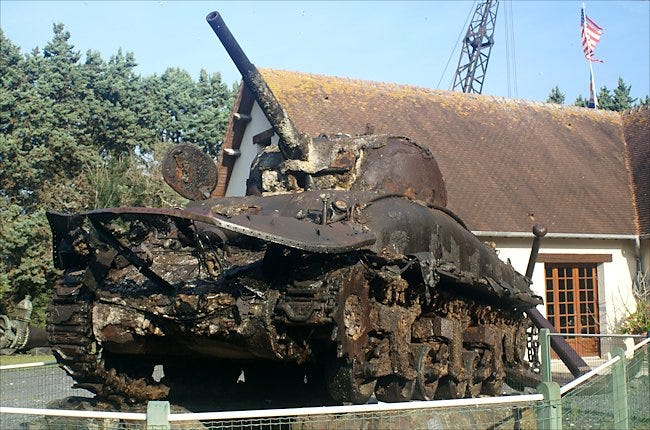D-Day's Amphibious Warriors: The Duplex Drive Sherman Tanks
In honor of the 80th anniversary of D-Day, I figured a piece on the main tanks used to storm the beaches would be appropriate. The Sherman Duplex Drive, more commonly referred to as Sherman DD, was one of the specialized vehicle types made by the British collectively known as “Hobart’s Funnies” to support the invasion of mainland Europe. The name was derived from the man in charge of the 79th Armored Division General Percy Hobart. The 79th Armored Division was formed to develop specialized designs to support troops in the invasion of mainland Europe. I will cover some of the other Funnies in later posts as they all played a valuable role in the war effort. An important note is that the Sherman was not the only tank equipped with a DD system as other tanks were also equipped with it, it’s just that the Sherman was the most common. To that end, I will start with a brief history of the duplex drive system.
We begin with the designer, Nicholas Straussler, a Hungarian engineer who moved to Britain in the 1930s and started working on amphibious tanks in 1927. The basic design has a tall canvas skirt around the top portion of the tank that can be folded while not in use along with a propeller driven by the rear idler wheels. The canvas skirt was held up by pneumatic tubes which allowed the tank to displace enough water to float. In July 1940 Straussler fitted a Tetrarch tank with the system and presented it to the Navy Construction Branch. The design was initially rejected as impractical, but Straussler continued and trialed the prototype in the Brent reservoir in June 1941. Later that year in December, sea trials took place at Langstone Harbor with relative success. As a result of these trials, the DD system was fitted on the Valentine tank as a prototype for further tests. Many of these such tanks are shown in the image below. Due to the success of this prototype, many valentines were fitted with the system. However, due to issues with the longevity of the tank while using the system and the Valentine being largely outclassed by most other tanks in service by the end of 1943, all of the tanks fitted were eventually scrapped. From then on, the main tanks equipped with the DD system were Shermans.

The Sherman DD was first mentioned in records in February 1943, long before the Valentine DDs were officially decided to be obsolete. Later the same year in August a large-scale order was made for Shermans to be modified with a DD system to replace the obsolete Valentines. The first trials were performed in October and unfortunately, the first Sherman DD tested sunk right off of the landing craft it launched from. The next month, following a successful demonstration of the Sherman DDs to US planners, pictures and blueprints were taken and Sherman DD production soon began in the US. A total of 350 Shermans were used and produced by the US based on the M4A1 variant. The British produced 259 based on the M4A2 Sherman III variant and 400 based on the M4A4 Sherman V variant. Many of these tanks were then used on D-Day in Operation Overlord. Next, I will explain how the Sherman DDs faired in their role.
The Sherman DDs were used on every beach on D-Day as they would be essential for supporting the landing infantry and working to destroy fortifications. 85% or more of the tanks landed on the beach successfully by swimming from offshore or being deployed after the landing craft reached shore at 4 of the 5 beaches. The 741st Tank Battalion and 743rd Tank Battalion were deployed at Omaha Beach with 32 tanks each. The 741st Tank Battalion headed toward shore first and launched 29 of their tanks 5000 Yds from shore. Of the 29 launched offshore, only 2 tanks made it to shore with the other 27 all sinking due to the rough waves. The 3 tanks that never launched were damaged by an explosion offshore and were deployed from their landing craft onshore. The 743rd Tank Battalion deployed all of their tanks from the landing craft once they were onshore after seeing the disaster that came before. This unfortunately meant that the 743rd Tank Battalion was 10 minutes late to land. Unfortunately, this was one of many factors that led to the high infantry casualties on Omaha Beach.
Today, only one surviving example of the Sherman DD exists that still has the canvas skirt. Many of the sunk Shermans were never recovered and are still on the sea floor. Some were also recovered and are on display at various locations around Europe. One example is the wreck pictured below, which is displayed at the D-Day Underwater Wrecks Museum in Normandy

.






